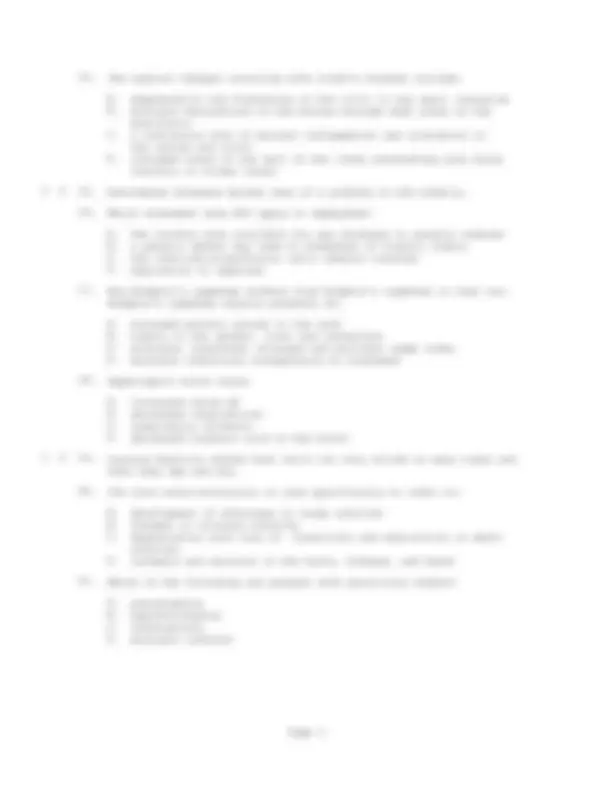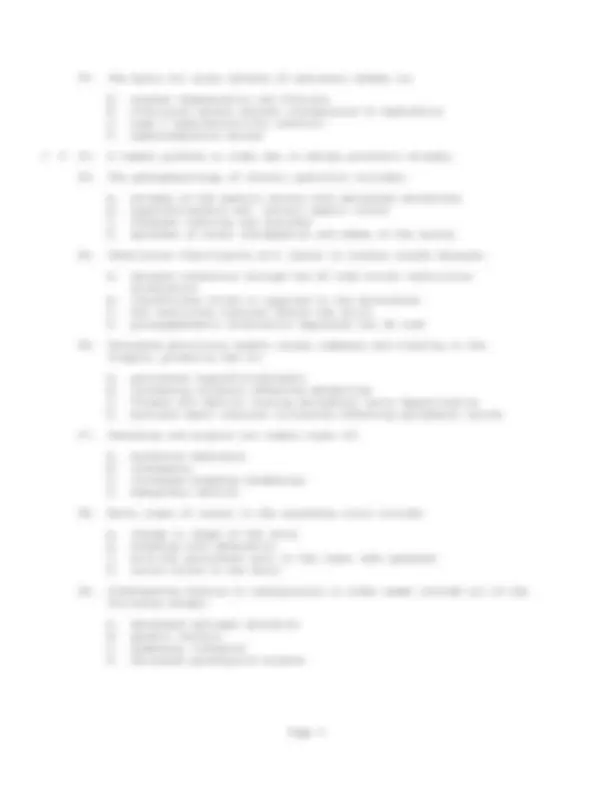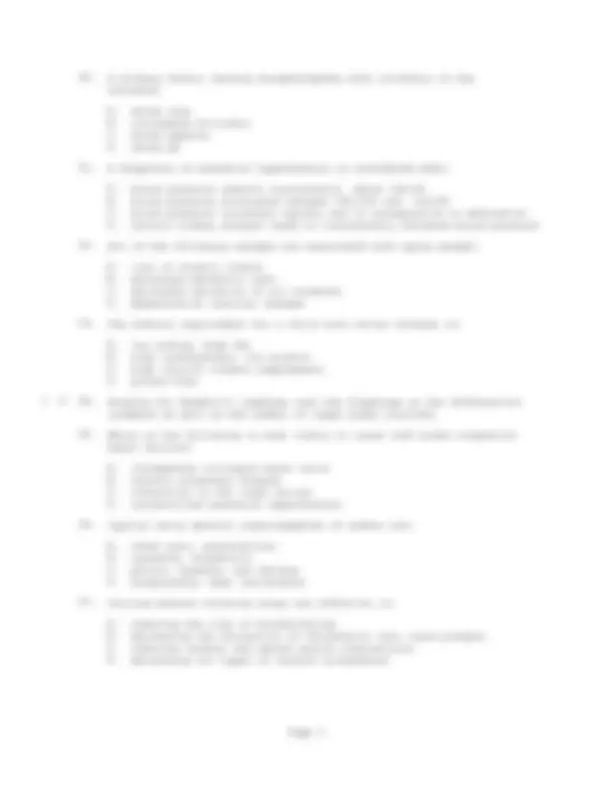





Study with the several resources on Docsity

Earn points by helping other students or get them with a premium plan


Prepare for your exams
Study with the several resources on Docsity

Earn points to download
Earn points by helping other students or get them with a premium plan
Community
Ask the community for help and clear up your study doubts
Discover the best universities in your country according to Docsity users
Free resources
Download our free guides on studying techniques, anxiety management strategies, and thesis advice from Docsity tutors
Material Type: Exam; Class: Pathophysiology; Subject: Biology; University: Missouri Western State University; Term: Unknown 1989;
Typology: Exams
1 / 6

This page cannot be seen from the preview
Don't miss anything!




BIO 375 Practice Exam 2
A. (^) causes metaplasia and dysplasia in the epithelium B. (^) promotes malignant changes in all types of benign tumors in the lungs C. (^) causes paraneoplastic syndrome D. (^) increases exposure to carbon monoxide in the lungs
A. (^) painful joints and skeletal deformity B. (^) abdominal discomfort and splenomegaly C. (^) excessive bleeding and recurrent infections D. (^) palpitations and chest pain
A. (^) the right ventricle pumps more blood than the left ventricle B. (^) pulmonary fibrosis and vasoconstriction increase vascular resistance C. (^) demands on the left ventricle are excessive D. (^) blood viscosity is increased, adding to cardiac workload
A. (^) 1, 3 B. (^) 2, 4 C. (^) 1, 3, 4 D. (^) 2, 3, 4
include:
A. (^) brief, substernal pain radiating to the right arm, with labored breathing B. (^) persistent chest pain radiating to the left arm, pallor, and rapid, weak pulse C. (^) bradycardia, increased blood pressure and severe dyspnea D. (^) flushed face, rapid respirations, left-side weakness and numbness
is true?
A. (^) both angina and MI cause tissue necrosis B. (^) angina often occurs at rest, MI occurs during a stressful time C. (^) pain is more severe and lasts longer with angina than with MI D. (^) angina pain is relieved by rest and intake of nitroglycerin, MI is not
A. (^) increased unconjugated bilirubin in the blood B. (^) increased bleeding tendencies C. (^) pale stool and dark urine D. (^) elevated liver enzymes in the blood
A. (^) the deficit of calcium ions B. (^) impaired production of prothrombin and fibrinogen C. (^) decreased platelets D. (^) dysfunctional thrombocytes
A. (^) 1, 3 B. (^) 1, 4 C. (^) 2, 3 D. (^) 1, 2, 4
A. (^) obstructive jaundice B. (^) acute pancreatitis C. (^) severe colicky pain D. (^) inflammation and infection in the gall bladder
A. (^) aspiration of saliva and food into the trachea B. (^) repeated reflux of gastric secretions into the esophagus C. (^) no fluid or food entering the stomach D. (^) gastric distention and cramps
is:
A. (^) widespread vascular degeneration B. (^) cumulative exposure to carcinogens C. (^) hereditary factors D. (^) increased immune surveillance
A. (^) a prolonged PR interval B. (^) periodic omission of a ventricular contraction C. (^) a wide QRS wave D. (^) spontaneous slow ventricular contractions, not coordinated with atrial contraction
A. (^) gradual degeneration and fibrosis B. (^) continuous severe attacks unresponsive to medication C. (^) type 1 hypersensitivity reaction D. (^) hyperresponsive mucosa
T F 23. A common problem in older men is benign prostatic atrophy.
A. atrophy of the gastric mucosa with decreased secretions B. hyperchlorhydria and chronic peptic ulcers C. frequent vomiting and diarrhea D. episodes of acute inflammation and edema of the mucosa
A. delayed conduction through the AV node blocks ventricular stimulation B. insufficient blood is supplied to the myocardium C. the ventricles contract before the atria D. parasympathetic stimulation depresses the SA node
A. persistent hyperbilirubinemia B. increasing acidosis affecting metabolism C. Vitamin B12 deficit causing peripheral nerve demyelination D. multiple small vascular occlusions affecting peripheral nerves
A. excessive hemolysis B. leukopenia C. increased bleeding tendencies D. hemoglobin deficit
A. change in shape of the stool B. bleeding with defecation C. mild but persistent pain in the lower left quadrant D. occult blood in the stool
A. decreased estrogen secretion B. genetic factors C. sedentary lifestyle D. decreased parathyroid hormone
A. (^) serum urea B. (^) conjugated bilirubin C. (^) serum ammonia D. (^) serum pH
A. (^) blood pressure remains consistently above 140/ B. (^) blood pressure fluctuates between 180/105 and 120/ C. (^) blood pressure increases rapidly and is unresponsive to medication D. (^) chronic kidney disease leads to consistently elevated blood pressure
A. (^) loss of elastic fibers B. (^) decreased metabolic rate C. (^) decreased secretion of all hormones D. (^) degenerative vascular changes
A. (^) low sodium, high fat B. (^) high carbohydrate, low protein C. (^) high calorie vitamin supplements D. (^) gluten-free
T F 34. (^) Staging for Hodgkin's lymphoma uses the diaphragm as the differential
landmark as well as the number of lymph nodes involved.
A. (^) incompetent tricuspid heart valve B. (^) chronic pulmonary disease C. (^) infarction in the right atrium D. (^) uncontrolled essential hypertension
A. (^) chest pain, palpitations B. (^) jaundice, stomatitis C. (^) pallor, dyspnea, and fatigue D. (^) bradycardia, heat intolerance
A. (^) reducing the risk of bloodclotting B. (^) decreasing the attraction of cholesterol into lipid plaques C. (^) reducing cardiac and smooth muscle contractions D. (^) decreasing all types of cardiac arrhythmias